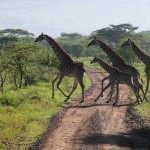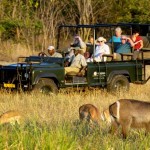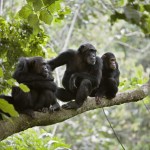The Spectacle Of Animal Migration
Posted On December 31, 2009
Common Info
Masai Mara wildlife safari in East Africa is the kind of experience that every nature/wildlife lover longs for throughout his/her life. Experiencing Masai Mara is not easy given the difficult accessibility and the lurking dangers (owing to the wild games) but yet it is an experience one would like to explore and feel to the core. Masai Mara is located in Kenya in eastern Africa. The area of the reserve is about 1,510 square kilometers (it was reduced from 1,672 square kilometers in 1984). The reserve is administered by Narok County Council and the Mara Conservancy, a local non-profit organisation.
Country Info
Kenya in eastern Africa (area: 5,80,367 square kilometres) has Ethiopia in the north, Somalia in the northeast, Tanzania in the south, Uganda in the west and Sudan in the northwest. Lake Victoria lies to its west while it has a coastline on the Indian Ocean in the east. Kenya gets its name from Mount Kenya, one of the significant mountain peaks in Africa. Kenya is known for its rich wildlife reserve. National capital is Nairobi.
Rift Valley
Rift Valley the largest administrative province in Kenya. The province, which has borders with Uganda, is dominated by the Great Rift Valley. Nakuru is the capital town.
Breathtaking Masai Mara
The natural set up at Masai Mara makes it a perfect backdrop for shooting a Hollywood classic but the rolling grasslands and the sprawling wilderness here give one a pulsating real-life thrill and joy. The naturalness of the Masai Mara can be understood from the fact that it is unfenced while its southern parts border the Serengeti National Park in Tanzania. Kenya and Tanzania share the vast Serengeti plains where wild games freely roam about (the dispersal area as it is known extend towards north and east of the Masai reserve) search of good grazing. Between July and October every year, several wildebeests, zebras, and gazelles arrive at Masai Mara from Serengeti to feed and relax.
Masai Mara fauna
Masai Mara features animals throughout the year and hence there is no possibility whatsoever that somebody will miss on them. Lions, elephants, leopards, hippopotamus, rhinoceros are abundantly spotted almost at every corner of the game reserve. Elands, topis and crocodiles are also found in the reserve. Even during the mass migration of the wildebeests, Masai Mara does not turn empty. The permanent water sources here support a permanent residence of animal herds. In the southwestern part of the park for instance, one may spot a roan antelope,bat-eared foxes and also Topi, a rare antelope. Other animals found here include impala, African Buffalo, Grant’s Gazelle, giraffe, warthog, waterbuck and others. The region also boasts of a rich avifauna population. Over 450 bird species have been recorded of which 57 are birds of prey.
Climate
The climate at Masai Mara is moderate with well-distributed rainfall throughout the year.
How to reach Masai Mara
Masai Mara National Reserve is about 270 kilometres from Nairobi and it takes about 4-5 hours by road to reach Masai Mara from Nairobi. Flights are also available from Nairobi twice daily and the journey is generally 40-45 minutes long.
Mara Serena Airport, Musiara Airport and Keekorok Airport are located in the Masai Mara Reserve area while Mara Shikar Airport, Kichwa Tembo Airport and Ngerende Airport are located in the Masai Mara Conservation area .
Masai Mara migration
Each year, in the wilderness of the Serengeti in south, the wildebeests and zebras start their long trek to the Kenya border and the Masai Mara. They exhaust the grazing lands in northern Serengeti and subsequently enter the Masai Mara National Reserve around the end of June. The sweet grasses here raised by the long April-May rains primarily allure them. More than half a million wildebeests, zebras, Thomson’s gazelles and elands enter the Masai Mara National Reserve while another 1,00,000 from the Loita Hills located to the east of the Masai Mara join them. Nothing else in the world can probably match the experience of driving in the midst of hundreds of thousands of animals. However, the migration takes its toll on the animals also. Many get drowned while crossing the Mara and Talek Rivers while many fall prey to the crocodiles in the river. Waiting predators too hunt down many while many succumb to exhaustion. After the reserve’s grass gets exhausted and fresh monsoons hit Tanzania, the herds set out for their return migration to Serengeti and Ngorongoro plains. The migration takes place in a circular fashion. However, the migration is a relatively new phenomenon which started in the 1960s. In the late 19th century, more than 90 percent of the wildebeest and cattle population in Masai Mara was killed by an epidemic. The Great Migration is a relatively recent phenomenon, dating back to the early 1960s. The disease could be eradicated following vaccination of the remaining cattle population here and the wildebeest population has shot up in Masai Mara ever since. The booming wildebeest population has compelled them to make migration in search of food and grazing lands.
Masai Mara accommodation
- Mara Serena Safari Lodge
- Mara Intrepids Club
- Siana Springs Intrepids Lodge
- Mara Sopa Lodge
- Sarova Mara Camp
- Mara Simba Lodge
- Kichwa Tembo Bateleur Camp
- Governors Camp
- Mara Explorer
- Private Governor’s Camp
- Kichwa Tembo Tented Camp
- Governors’ Private Camp
- Governor’s Il Moran Camp
- Mara Safari Club
- Rekero Cottages
Attractions at and around Masai Mara
- Visiting game reserve
- Balloon safari including view of the surrounding landscape from top of a balloon, witnessing the rising sun between the mountains and the assembly of the animals at the river.
- Wildlife migration

- Trip to nearby Maasai village
- Fishing excursions to Lake Victoria
- Expedition to Mfangano Island Camp in Lake Victoria
- Ngorongoro is home to a dense population of mammal predators like black rhino and black-manned lion
- Lake Manyara National park which is well-known for elephants and birds and baboons
Photography at Masai Mara
Not all animals at Masai Mara can easily be photographed. Baboons, elephants, zebras, gazelles and giraffes can be easily photographed but leopards, African hunting dogs and black rhinoceros are very very difficult to be shot. Hippopotamus, crocodile and cheetah are also not very easy to be shot.














Africa land of the jungle and animals!! The only destination where you can see an leopord hunting down a dear live! simply amazing! this article is presented very well and in a decent manner.